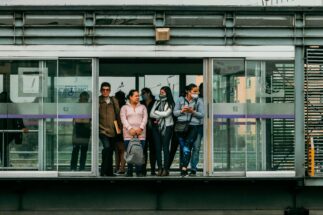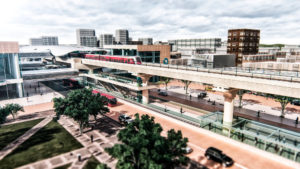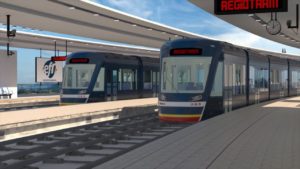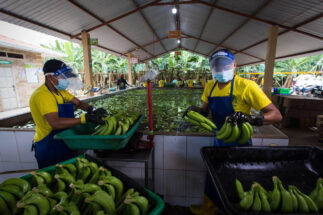As far back as the 1940s, Bogotá dreamed of having a metro system, as newspapers of the time testify. Almost 80 years later, hopes of improved urban mobility in the congested Colombian capital finally appear to be materialising.
On 27 November 2019, Empresa Metro de Bogotá (EMB) and a Chinese consortium made up of China Harbour Engineering Company Limited (CHEC) and minority partner Xi’an Metro Company Limited signed a contract to begin construction of Metro Line 1. It was a long-overdue development for a city of more than 11 million inhabitants and the fifth most populous in Latin America.
Progress since has not been entirely smooth, though, as the Covid-19 pandemic and a prolonged wave of protests gripped Colombia and stalled construction in the capital. Late 2021, however, saw official ground-breakings and inaugurations finally set work on the metro underway, with Line 1 now projected to begin service in 2028. Much needed relief for the city’s strained transport system is on the horizon, but there may yet be a bumpy track ahead, as complaints and concerns among citizens and senators remain.
Breaking the gridlock
Residents of Bogotá spend an average of 52 minutes travelling to work or school each day, according to Numbeo, a global database of quality of life indicators in different cities. The near two-hour daily roundtrip, punctuated by gridlocks and traffic lights, makes it the South American city in which people spend the most time getting around.
In 2020, transport analytics consultancy Inrix again ranked Bogotá as the worst city for car traffic anywhere in the world, even as time spent in traffic was down on pre-pandemic levels. According to their research, in 2019, Bogotá residents lost, on average, around 191 hours to traffic. The desperate need for better public transport alternatives could hardly be clearer.

The new plan also envisages numerous public works that will improve mobility in Bogotá during the 2022–2035 period it covers, including new tram routes, high-speed lanes, cable cars and, most notably, the first line of the metro. It is the largest infrastructure project in the country, projected to cost 13 trillion Colombian pesos (approximately US$3.5 billion).
Elsewhere, a series of initiatives introduced by López in response to the pandemic recently earned Bogotá the Institute for Transport and Development Policy’s Sustainable Transport Award, recognising the implementation of temporary cycle routes, the introduction of 1,485 electric buses and car-sharing incentives.
Colombia’s transport networks could further benefit from foreign investment catalysed by the G7’s B3W scheme, an embryonic, alternative infrastructure plan to China’s Belt and Road Initiative (BRI) that the Latin American nation endorsed last year. In September 2021, Colombia’s transport minister Ángela María Orozco was one of a number of cabinet members to meet with US deputy national security advisor Daleep Singh and US Development Finance Corporation (DFC) Chief Operating Officer David Marchick, to explore cooperation on infrastructure projects.
Yet, urban mobility is only one of Bogotá’s pressing social issues, and since the award of the metro construction contract, others have risen up the agenda. In a city accustomed to waiting, residents have had to do so a little longer.
Metro gets underway
As well as the disruption of the pandemic, which halted progress soon after the signing of the construction contract in late 2019, unprecedented citizen protests against fiscal reforms proposed by President Ivan Duque’s government erupted in April 2021. Demonstrations persisted for months, after evolving into broader demands to tackle longstanding inequality, bringing the entire country to a standstill and further delaying any attempt to restart work on the metro.
72,000
The number of passengers Line 1 of the Bogotá Metro will be able to carry per hour in each direction, providing a much needed alternative for residents of the congested Colombian capital
Despite the social upheaval, works managed to start in August, with the inauguration of a trainyard that will accommodate the first metro line’s 30 trains. The following month, ground was broken for the track itself, at an intersection in the city centre. The line is planned to stretch across a total of 24 kilometres and carry as many as 72,000 passengers per hour, in both directions.
EMB announced in February that construction of the trainyard project is around 16% complete and has suggested that they will meet delivery dates ahead of schedule. Mayor López welcomed the announcement on Twitter.
As well as easing the city’s congestions woes, the Bogotá Metro is also expected to stimulate Colombia’s economy, through generating employment and promoting national steel and cement production chains, according to Jose Stalin Rojas, director of the Observatory of Logistics, Mobility and Territory of the National University of Colombia.
Today, according to Semana magazine, there are already 253 companies registered as subcontractors and suppliers on a portal run by Metro Línea 1 SAS, the company created by the Chinese consortium partners. Of these companies, 190 are local and stand to benefit from the works, while approximately 17,000 direct and indirect jobs will be created.
Semana’s report adds that during the construction process alone, 370 indirect jobs will be created in 2022. The construction of the interchange at Calle 72 and Caracas Avenue – the location of the ground-breaking in September – will continue through 2022 and create 130 indirect jobs.
Though things seem to have started positively, not everyone agrees.
Latest complaint
On the same day that the EMB announced its rate of progress, national senate candidate Hollman Morris filed a criminal complaint against López and former Bogotá mayor – and current presidential hopeful – Enrique Peñalosa, who held the office when the concession was awarded, for alleged irregularities in the contracting process.
“The mayor owes an explanation to the people of Bogotá,” Morris said. “6 billion pesos (US$1.6 million) [went] to these two consortiums, Garrigues and KPMG, illegally, without justification. 6 billion pesos of Colombians’ taxes were paid by the Bogotá Metro company, without previous studies and which were not included in the contract.”
They only say the metro is corrupt because it is not their project
Peñalosa responded to Morris’ claims via Twitter by saying he was a “typical” ally of Gustavo Petro – another former Bogotá mayor and current presidential hopeful – in that he “just talks, he’s not rigorous, doesn’t study, doesn’t understand, and, of course, does nothing”, adding: “what’s certain is that Petro did nothing, but we CONTRACTED the Metro.”
Meanwhile, López dismissed any allegations of criminality from Morris, describing them merely as “points for improvement”. She told a local radio station that Bogotanos should “rest easy”, and that she would lead work addressing these, before taking a swipe at her rivals: “For them, the metro is corrupt because it is not theirs.”
Citizen doubts
Beyond supposed financial irregularities, construction of the metro is also reportedly affecting the quality of life for some, Fabio Prieto, a member of the Vecinos del Metro (Neighbours of the Metro) community group created to monitor the project’s impacts, told Diálogo Chino. He said city residents are not being properly consulted.
“When you go [to the EMB] and ask something, they always say ‘no, that’s private’. So why do they do a citizen participation exercise? It’s very tiring,” said Prieto, annoyed by the company’s secrecy. Diálogo Chino tried to contact the company to obtain information beyond what is available on its website, but did the company did not respond.
Prieto claims that in Santa Isabel, one of the neighbourhoods in southern Bogotá through which the first metro line will pass, the company gave the community inaccurate information.
In August, residents of Santa Isabel were informed that 59 houses were to be demolished, Prieto said, pointing to a local government document released at the time. In 2020, he added, they had been informed that work would only encroach “50 or 90 cm” into front gardens of affected properties. But residents are sceptical, and claim that EMB has not declared the full extent of demolitions, with some suggesting that “half the neighbourhood” might be affected, according to Prieto.
Diálogo Chino attempted to contact the company for clarification on this issue, but as of publication, no response had been received.
Omar Oróstegui, a political scientist and former director of the organisation Bogotá Cómo Vamos, thinks that “the process is already very advanced, so this should not be a concern”.
“The first stage was the negotiation of land, now there is very little left to acquire. As it is an elevated metro, very few considerable areas of intervention are really needed,” he told Diálogo Chino, adding that he hoped these conflicts can be resolved.
A second line is coming
Despite the complaints, the government and the Bogotá mayor’s office announced the construction of the second metro line in June 2021. This section will be underground and is intended to benefit more than 2.5 million inhabitants. It will cost 13 trillion pesos (approximately $3.5 billion), extend 15.8 kilometres and have 11 stations. According to the EMB, it will be operational in 2030.
“The second line of the Bogotá Metro will be structured and financed during the government of Iván Duque. In two years we have done for the second line what it took 10 years [to do] for the first,” López claimed.
According to a statement from the EMB, as part of the contract between the company and Financiera de Desarrollo Nacional, an agency that promotes private sector participation in public works, geotechnical explorations for the line began on 21 December 2021. For the time being, no further progress on the work has been announced.
What is known is that the network will consist of 26 trains and carry up to 60,000 passengers per hour in each direction, fuelling Bogotanos’ hopes that an end to their long collective wait is finally on the horizon.








